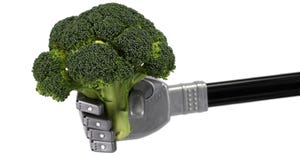HDPE resin is produced from the chemical compound ethylene. HDPE bottles are blow-molded. Bottles are used for detergent, shampoo, motor oil, milk and other liquid products, and drugs and cosmetic products. Milk bottles are the single biggest HDPE package. Most milk and water bottles use a natural-colored HDPE resin. Bottles used for detergents, shampoos and other products often have colorants added to the resin.
Injection-molded HPDE containers are used for products such as margarine and yogurt. Bottles have 90 percent of the HDPE “rigid package” market, while containers have the remainder.
Additionally, HDPE resin can be used to make flexible packaging such as sacks, trash bags and bottle caps. Bottles and containers are almost half of all HDPE packaging products. HDPE bottles and containers use the No. 2 in the plastic resin code.
HDPE bottles and containers began displacing heavier metal, glass and paper packages in the 1970s. Although the amount of HDPE used in packages has almost tripled since 1980, HDPE's solid waste market share is still less than 1 percent.
This profile only covers HDPE bottles and containers.
Chaz Miller is state programs director for the Environmental Industry Associations, Washington, D.C. E-mail the author at: [email protected]
Sources:
American Plastics Council, Washington, D.C.
www.plasticsresource.org
“Design for Recycling, A Plastic Bottle Recyclers Perspective,” Society of Plastics Industries, Washington, D.C., February 1992.
www.socplas.org
Measurement Standards and Reporting Guidelines, National Recycling Coalition, Washington, D.C. www.nrc-recycle.org
Modern Plastics, New York, February 2002.
www.modplas.com
“Municipal Solid Waste in the United States: 2000 Facts and Figures,” EPA, Office of Solid Waste, 2002.
www.epa.gov/osw
“Scrap Specifications Circular 2002,” Institute of Scrap Recycling Industries, Washington, D.C.
www.isri.org
*2000 EPA estimates.
HPDE Bottles Municipal Solid Waste (MSW) Facts:
Generated:
1.88 million tons or 0.81% by weight.*
13.4 pounds per person.*
85% generated at home, 15% at businesses.
Recycled:
380,000 tons or a 20.2% recycling rate.*
210,000 tons of liquid bottles or a 30.4% recycling rate.*
170,000 tons of other bottles and containers or a 14.3% recycling rate.*
Recycled Content:
Some non-food bottles have small amounts of recycled HDPE.
Composted:
HPDE does not compost.
Incinerated or Landfilled:
1.5 million tons or 0.64% of discarded MSW by weight.*
18,690 Btus per pound of HDPE (MSW is 4,500 Btus to 5,000 Btus per pound).
Not biodegradable in landfills.
Landfill Volume:
6.3 million cubic yards or 1.5% of landfilled MSW.
Density:
Landfilled milk jugs are 355 pounds per cubic yard.
Loose milk jugs are 24 pounds per cubic yard.
Flattened milk jugs are 65 pounds per cubic yard.
Loose, colored HDPE bottles are 45 pounds per cubic yard.
Bales of HDPE generally weigh 500 pounds to 800 pounds.
Source Reduction:
In 1970, an empty 1 gallon milk jug weighed 95 grams; now it weighs less than 60 grams.
Recycling Markets:
Packaging, drainage pipe, film, pallets, plastic lumber and exports.
HDPE has the best plastics recycling markets.
End-Market Specifications:
ISRI Baled Recycled Plastic Standard P-200 (HDPE Mixed), P-201 (HDPE Natural) or P-202 (HDPE Pigmented) for bottles. The specs allow for 2% contamination, no free liquids and UV protection.There are no ISRI specifications for containers.
Injection-molded containers are often incompatible with blow-molded bottles in reprocessing operations.
About the Author(s)
You May Also Like




